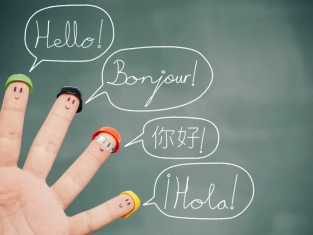by PushtoLearn
Top-10 Easiest Languages For English Speakers To Learn
Table of Contents
- What Makes a Language Easy to Learn?
- Top 10 Easiest Languages for English Speakers
- 1. Norwegian – The Easiest Language to Learn!
- 2. Swedish – Simple and Familiar
- 3. Spanish – Most Useful & Easy
- 4. Dutch – English’s Close Cousin
- 5. Portuguese – Music & Culture Make It Fun
- 6. Indonesian – The Easiest Asian Language
- 7. Italian – Deliciously Easy
- 8. French – Familiar, But Tricky Pronunciation
- 9. Swahili – Africa’s Lingua Franca
- 10. German – Challenging, But Logical
- FAQs
What Makes a Language Easy to Learn?
A language is considered "easy" if it has:
✅ Similar Vocabulary – The more words that resemble English, the better!
✅ Familiar Grammar – Simple rules and minimal exceptions make learning easier.
✅ Easy Pronunciation – Fewer tricky sounds and straightforward spelling help with speaking and reading.
✅ Latin Alphabet – If a language uses the same alphabet as English, it's a big advantage.
✅ Lots of Learning Resources – The more exposure through TV, music, and apps, the easier it is to practice.
Top 10 Easiest Languages for English Speakers
|
Rank |
Language |
Language Family |
Why It's Easy |
|
1 |
Norwegian |
Germanic |
Similar grammar & vocabulary, flexible pronunciation |
|
2 |
Swedish |
Germanic |
Simple grammar, many cognates, phonetic spelling |
|
3 |
Spanish |
Romance |
Shared Latin roots, phonetic pronunciation, worldwide use |
|
4 |
Dutch |
Germanic |
Similar vocabulary to English, simple sentence structure |
|
5 |
Portuguese |
Romance |
Familiar words, phonetic spelling, Brazilian pop culture |
|
6 |
Indonesian |
Austronesian |
No verb conjugations, phonetic alphabet, simple structure |
|
7 |
Italian |
Romance |
Many English cognates, phonetic pronunciation, food culture |
|
8 |
French |
Romance |
Shared vocabulary, global presence, exposure in media |
|
9 |
Swahili |
Bantu |
Logical grammar, phonetic spelling, English loanwords |
|
10 |
German |
Germanic |
Shared roots with English, straightforward pronunciation |
(Based on estimates from the Foreign Service Institute (FSI), these languages take around 24-30 weeks (600-750 hours) of study for English speakers to reach proficiency.)

1. Norwegian – The Easiest Language to Learn!
Why is Norwegian the easiest language to learn?
-
Grammar is straightforward – Verbs don’t change much (e.g., “I go,” “you go,” “he goes” all use the same verb form: jeg går).
-
Word order is similar to English – “Can you help me?” → Kan du hjelpe meg?
-
Pronunciation is flexible – Different accents are all acceptable!
⭐ Worth learning? Yes! Norway has a high standard of living, and knowing Norwegian can help with Swedish and Danish, too.
2. Swedish – Simple and Familiar
Why is Swedish easy?
-
Many English-Swedish cognates – “Grass” = gräs, “moon” = måne.
-
Phonetic spelling – Words are pronounced how they look.
-
Exposure through IKEA! – Many product names are actual Swedish words.
⭐ Worth learning? Absolutely! Swedish is widely spoken in Scandinavia and opens doors to Norwegian and Danish.
3. Spanish – Most Useful & Easy
Why is Spanish easy?
-
Shared Latin roots – “Correct” = correcto, “delicious” = delicioso.
-
Phonetic pronunciation – Words are spoken as they’re written.
-
Global exposure – Spanish is the second most spoken language in the world!
⭐ Worth learning? Definitely! Spanish is widely spoken in the U.S., Latin America, and Europe, making it incredibly practical.
4. Dutch – English’s Close Cousin
Why is Dutch easy?
-
Many English words are the same in Dutch – “Rat” = rat, “lamp” = lamp.
-
Grammar is straightforward – Similar sentence structure to English.
-
No complicated verb endings like in German.
⭐ Worth learning? Yes! Dutch is spoken in the Netherlands, Belgium, and Suriname, and it helps if you want to learn German later.
5. Portuguese – Music & Culture Make It Fun
Why is Portuguese easy?
-
Similar to Spanish – If you know Spanish, learning Portuguese is much easier.
-
Phonetic pronunciation – Words are generally spoken as written.
-
Cultural exposure – Brazilian music, movies, and food help with learning!
⭐ Worth learning? Absolutely! Portuguese is the sixth most spoken language worldwide.
6. Indonesian – The Easiest Asian Language
Why is Indonesian easy?
-
Uses the Latin alphabet – No complicated characters like in Chinese or Thai.
-
No verb conjugations – Saya makan = “I eat,” Dia makan = “He/she eats” (same verb form!).
-
Simple pronunciation – Words are pronounced exactly as they’re spelled.
⭐ Worth learning? Yes! Indonesia has 270+ million people, making it a major language in Asia.
7. Italian – Deliciously Easy
Why is Italian easy?
-
Many English-Italian cognates – “Future” = futuro, “control” = controllare.
-
Phonetic pronunciation – No tricky silent letters.
-
You already know food-related words! – Pasta, pizza, mozzarella!
⭐ Worth learning? Yes! Italian is great for travel, culture, and understanding art, music, and history.
8. French – Familiar, But Tricky Pronunciation
Why is French easy?
-
Lots of English-French vocabulary – Déjà vu, ballet, café, avant-garde.
-
Grammar is similar to Spanish & Italian – If you know one, French will be easier.
-
Exposure in media – Many English words come from French due to historical influence.
⭐ Worth learning? Yes! French is spoken in Europe, Africa, Canada, and the Caribbean.
9. Swahili – Africa’s Lingua Franca
Why is Swahili easy?
-
Phonetic spelling – Words sound how they are written.
-
English loanwords – Penseli (“pencil”), mashine (“machine”).
-
Simple grammar – Logical sentence structure with minimal exceptions.
⭐ Worth learning? Yes! Swahili is widely used in East Africa and is great for travel and business.
10. German – Challenging, But Logical
Why is German easy?
-
Many shared words – “Hand” = Hand, “name” = Name.
-
Logical sentence structure – Once you learn the rules, it makes sense!
-
No tones or complex scripts – Uses the Latin alphabet.
⭐ Worth learning? Yes! German is the most spoken language in Europe and is useful for business and travel.
Ready for the next challenge? Have a look at Hardest Languages For English Speakers To Learn
FAQs
What is the easiest language to learn for English speakers?
Norwegian is the easiest due to its grammar and vocabulary similarities.
What is the fastest language to learn?
Spanish is the quickest because of its widespread exposure and phonetic pronunciation.
Which language is easiest for travel?
Spanish, French, and Italian are the most useful for international travel.
What is the easiest Asian language?
Indonesian is the easiest due to its Latin alphabet and simple grammar.
Which language is easiest for business?
German, Spanish, and French are great for global business opportunities.

